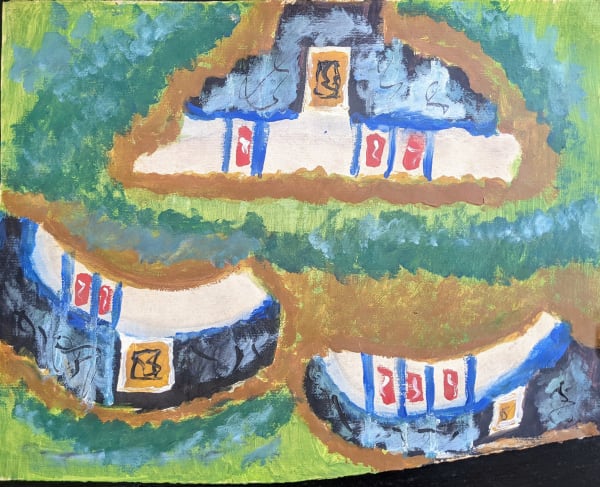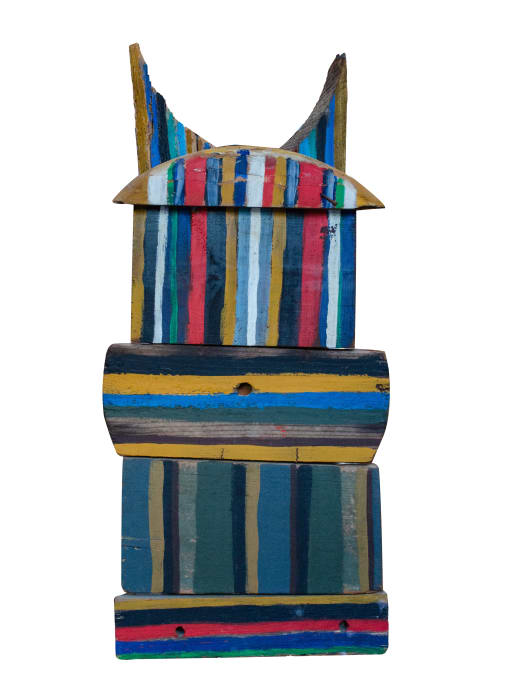Works
Biography
Renowned as an esteemed and legendary art dealer who for more than three decades was devoted to encouraging and championing many of the leading artists of the mid- and late- twentieth century, Betty Parsons was also an accomplished artist in her own right, who developed a penetrating and original vision in response to the abstract art of her era. She exhibited her work regularly during her lifetime, and several shows have been dedicated to her role as a dealer since her death. She transcended the often purely formal and dogmatic issues that preoccupied much of mid-twentieth century abstraction after Abstract Expressionism began to be viewed as a school akin to a new academy in the late 1950s.
Born in 1900 into a socially prominent and wealthy family, Betty Parsons showed her independent streak early. At age thirteen she had her first electrifying experience of Modernism in the spectacle at the Armory Show of 1913, which showcased the European avant-garde. While many New Yorkers found the art of the Cubists and Futurists to be shocking, it enthralled Parsons, forging her determination to become an artist, and she aspired to be a sculptor like Antoine Bourdelle, the French sculptor, who was her favorite artist at the time. Her family expected her to follow a traditional path, to the extent of marrying, which she did in 1919. Unhappy in her marriage, she divorced in 1924, leaving that year for Paris, where she set out to fulfill her earlier dream of pursuing a career as an artist. Enrolling at the Académie de La Grand Chaumière, she studied with Bourdelle, Alexander Archipenko, and the sculptor and painter Ossip Zadkine. One of her classmates was the Swiss sculptor Alberto Giacometti and her circle of friends included Man Ray and the American sculptor Alexander Calder. Parsons also received instruction in painting and watercolor from the English artist Arthur Lindsay.
The first exhibition of Parsons's work was held in Paris in 1933, shortly before the Great Depression severed her income and forced her to return to the United States. Initially she went to California, where she had a show of her work in Los Angeles in 1934, before she came back to New York in 1935. That year she began her association with Midtown Galleries, where she subsequently had ten solo shows, the last in 1957. In 1936 she had her first experience in selling art, working for Midtown Gallery. She then held a variety of jobs, including serving as director of Wakefield Gallery and of Mortimer Brandt Gallery, before opening her own gallery in 1946.
At her gallery on 57th Street Betty Parsons held groundbreaking shows for Jackson Pollock, Clyfford Still, Mark Rothko, Ad Reinhardt, and Barnett Newman, which were instrumental in gaining Abstract Expressionism its first important foothold in the postwar art scene and for establishing these artists as the movement's leaders. When some members of the art world had doubts about this group, Parson's considered them "great innovators" She gave many contemporary artists their first solo shows in New York, including Robert Rauschenberg, Agnes Martin, Richard Tuttle, and Ellsworth Kelly.
Although Parsons did exhibit her work and was given a solo exhibition at London's prestigious Whitechapel Gallery in 1968, her paintings were never fully appreciated during her years as a gallery owner. Indeed, her fame as an art dealer created an extra burden. It was thought unseemly for art dealers to compete with artists.
Parsons died in New York City in 1982. Her work may be found in numerous public collections, including the Parrish Art Museum, Southampton, New York; The High Museum, Altanta, Georgia; the Whitney Museum of American Art, New York; and the Smithsonian American Art Museum, Washington, D.C.
Born in 1900 into a socially prominent and wealthy family, Betty Parsons showed her independent streak early. At age thirteen she had her first electrifying experience of Modernism in the spectacle at the Armory Show of 1913, which showcased the European avant-garde. While many New Yorkers found the art of the Cubists and Futurists to be shocking, it enthralled Parsons, forging her determination to become an artist, and she aspired to be a sculptor like Antoine Bourdelle, the French sculptor, who was her favorite artist at the time. Her family expected her to follow a traditional path, to the extent of marrying, which she did in 1919. Unhappy in her marriage, she divorced in 1924, leaving that year for Paris, where she set out to fulfill her earlier dream of pursuing a career as an artist. Enrolling at the Académie de La Grand Chaumière, she studied with Bourdelle, Alexander Archipenko, and the sculptor and painter Ossip Zadkine. One of her classmates was the Swiss sculptor Alberto Giacometti and her circle of friends included Man Ray and the American sculptor Alexander Calder. Parsons also received instruction in painting and watercolor from the English artist Arthur Lindsay.
The first exhibition of Parsons's work was held in Paris in 1933, shortly before the Great Depression severed her income and forced her to return to the United States. Initially she went to California, where she had a show of her work in Los Angeles in 1934, before she came back to New York in 1935. That year she began her association with Midtown Galleries, where she subsequently had ten solo shows, the last in 1957. In 1936 she had her first experience in selling art, working for Midtown Gallery. She then held a variety of jobs, including serving as director of Wakefield Gallery and of Mortimer Brandt Gallery, before opening her own gallery in 1946.
At her gallery on 57th Street Betty Parsons held groundbreaking shows for Jackson Pollock, Clyfford Still, Mark Rothko, Ad Reinhardt, and Barnett Newman, which were instrumental in gaining Abstract Expressionism its first important foothold in the postwar art scene and for establishing these artists as the movement's leaders. When some members of the art world had doubts about this group, Parson's considered them "great innovators" She gave many contemporary artists their first solo shows in New York, including Robert Rauschenberg, Agnes Martin, Richard Tuttle, and Ellsworth Kelly.
Although Parsons did exhibit her work and was given a solo exhibition at London's prestigious Whitechapel Gallery in 1968, her paintings were never fully appreciated during her years as a gallery owner. Indeed, her fame as an art dealer created an extra burden. It was thought unseemly for art dealers to compete with artists.
Parsons died in New York City in 1982. Her work may be found in numerous public collections, including the Parrish Art Museum, Southampton, New York; The High Museum, Altanta, Georgia; the Whitney Museum of American Art, New York; and the Smithsonian American Art Museum, Washington, D.C.
Enquire





